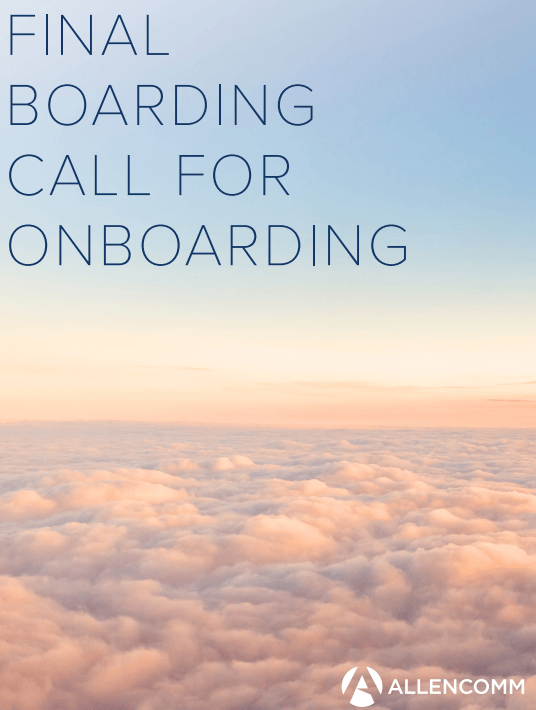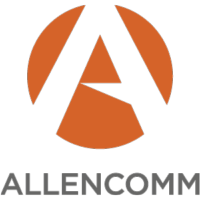How To Sprint Strategically: Taking A Fresh Look At New Employee Onboarding Programs
Lately, there’s been a surge of interest in new ideas and approaches to onboarding or new hire programs, which makes sense, since onboarding of new employees and reskilling of existing staff is a mainstay of our work. Recent research links onboarding to critical corporate objectives and highlights the lack of structure in this practice. Organizations such as Forbes, American Express, and SHRM have isolated the critical components of onboarding, and the Human Capital Institute has identified some best practices.

At AllenComm, however, we are seeing a mismatch between this discussion and the realities our clients deal with in finding and acclimating new hires. Unlike other areas of corporate development, such as leadership, sales, or compliance, new ideas and processes for onboarding programs are lacking. Complex processes and programs have steamrolled the human element that we believe is necessary for successful onboarding. To be more strategic in this area, ask yourself, “Does my company see onboarding as a marathon or a sprint?”
For many L&D departments, onboarding is a convergence of formal and informal employee socialization. Much of the discussion is taken over by the need to acclimate the new hire into the culture and brand of the organization. While we put great importance on the connection of brand education to employee success, we find that there is often confusion between what is necessary versus what is sufficient.
The two major objectives of onboarding (holding compliance issues and corporate governance as constants for all employees) are socialization and time to competency. Both have been linked to higher employee retention, productivity, and engagement. For a fresh look at this topic, it’s worth looking at these objectives through the “necessary and sufficient” prism.
I have observed that giving employees the feeling of competency and providing feedback tend to be necessary conditions of any positive socialization. Will employees who feel they have proven themselves in their new job be more receptive to the socialization component of your onboarding program? Conversely, can any culture or brand overcome feelings of inadequacy or frustration with a new job or task?
Consider whether you agree with the following statement:
“A competent hire may be hired away if they feel there is a cultural mismatch, but a non-competent hire will stay if they feel a cultural fit.”
Clearly, I am not proposing that you ignore one of the other critical parts of onboarding, but we need to prioritize our focus, and it’s important to get everyone together on a more strategic approach to onboarding.
Your program must reflect the balance or hierarchy of these two components: socialization and time to competency. Each of us remembers our own onboarding experiences and the firehose of information to which we were subjected. Use cognitive load theories (Sweller) as a guide for structuring your program's effectiveness.
Best Practices For An Effective New Employee Onboarding Experience
Here are some principles and practices that we find useful:
- Both formal and informal settings are tools for the socialization and competency components of your program.
- In the pre-hire process, try to isolate where your new hires’ anxieties lie. We find that concerns about job performance will overcome anxiety about social or cultural fit.
- While many articles point to year-long strategic onboarding programs, using a 30-60-90-day structure can enable shorter sprints if needed.
- Develop confidence-building measures that allow new hires to reflect on their journey toward competency and cultural fit.
- While some sought-after brands can experiment with their onboarding process, spending too much of your time weeding out candidates with a subpar cultural fit is not a luxury most organizations can afford. Moreover, it can create a lack of social diversity that can have diminished returns.
- The best onboarding program is only as good as your ability to change it based on the feedback of each cohort.
Adopting a “sprinting” process creates flexibility that highly structured programs lack. Aspects of brand and culture can be scaled over the whole organization. In the realm of competency, we find short, focused primers and on-the-job support to be critical in building new employee confidence. New technologies and portals make even these activities scalable. Building the confidence of new hires through proper feedback is critical, and leaving time for self-reflection activities can lessen cognitive load along the way. The cost of little or no structured onboarding is high. For those taking a fresh look at preparing new or existing hires for success, a highly segmented process with the proper cultural and brand context can have promising results.
If you want to learn more about how to create a successful onboarding experience for your new hires, download the eBook Final Boarding Call For Onboarding.
Related articles:
1. 3 Tips For Successful New Employee Onboarding
2. Best Practices For Successful New Employee Onboarding Outcomes
3. eBook: Final Boarding Call For Onboarding
Additional Resources:
- Digital onboarding tools are an efficient way to track the journey, engagement, performance, and retention. (Ferrazzi, 2015)
- Overcoming the negative myths of rapid onboarding to get employees up to speed quickly. (Keith Rollag S. P., 2005)
- The faster new hires feel welcome and prepared for their jobs, the faster they will be able to successfully contribute to the firm’s mission. (Talya N. Bauer, 2017)


